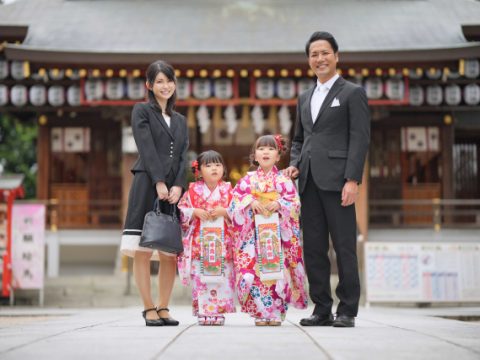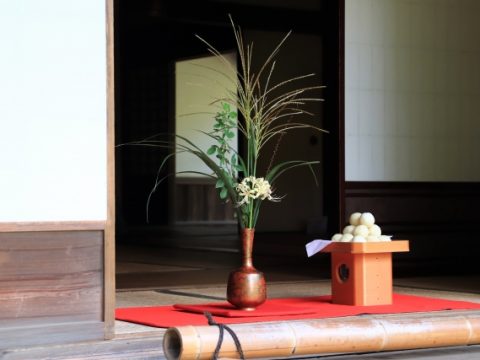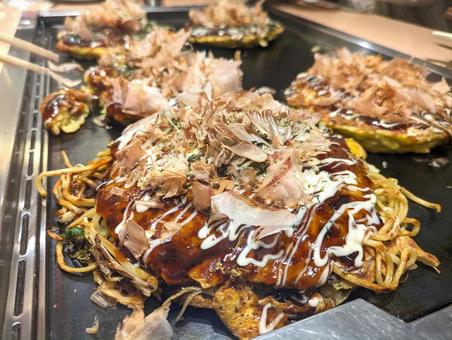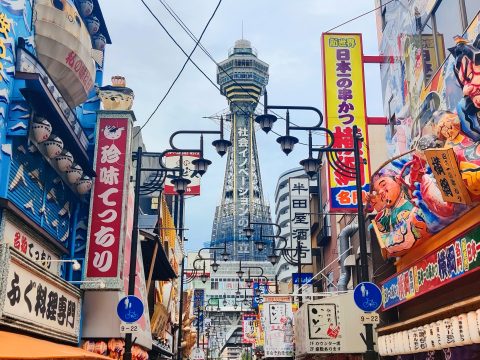Katsuobushi (鰹節)
JAPANESE FOODS
12.06.2023
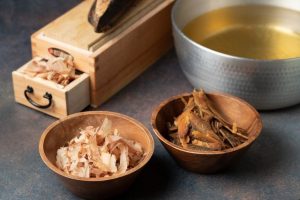
In the last article, I talked about the beloved fish: Katsuo(鰹 or かつお). It has been one of the essential ingredients in Japanese food culture. In this article, I will talk about Katsuobushi (鰹節 or かつお節), which is dried Katsuo.
Why is Katsuo essential in Japanese food?
If you have made Japanese food, you already know that Dashi is often used in Japanese cooking. The most common ingredient to make Dashi is “Katsuobushi,” also called dried bonito in English. Katsuobushi is also used as seasonings and toppings in many Japanese foods, making it one of the most essential ingredients.

Origin of Katsuobushi
The origin of Katsuobushi started in the early 700s as “Katauo (堅魚),” which means “hard fish,” and “ni-katauo (煮堅魚),” which means “boiled hard fish.” Katauo was a form of Katsuo cut in fillets and dried in the sun. Ni-Katauo was boiled first, then dried in the sun. Afterward, the stock from ni-katauo was reduced to create concentrated seasonings, which was called “Katsuo no irori (堅魚煎汁).” These three items were specified as tributes in some regions of Japan for a long time.

Start of the smoking process
In the Muromachi era (1336 -1573), there was a written record of “Hanagatsuo (花鰹),” which is shaved fish flakes. Researchers believe that the smoking process was added around this time. This preserving technique was believed to originate from the Maldives through Ryukyu island (Okinawa island in the present day).
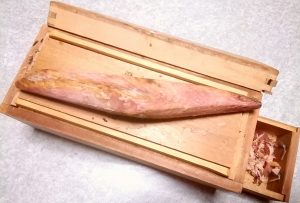
At first, straw was used to create smoke. However, a century later, the fisherman in Wakayama decided to use wood instead. By switching to wood smoke, the fish became harder and drier, which resulted in a more extended preservation period. This technique was kept secret within the family for a generation until the second generation shared it with people in the Tosa area. The method was kept confidential within those two regions for a long time. The smoked katsuobushi is called “Arabushi,” which has a strong umami flavor and is still used today.
More improvement
There are different theories regarding the origin of the next improvement, but the story usually goes that someone found Arabushi with a mold. The individual decided to use it anyways. This action led to the discovery of enhanced flavor with fermentation. Around 1770, people in Tosa started applying mold to Arabushi to improve its taste. Mold also consumes moisture left in the meat, decomposes fat, and keeps off other microorganisms, leading Katsuobushi to have a longer shelf life. This Katsuobushi is called “Honkarebushi.” It can last up to 2 years in the proper condition.
Process of making Katsuobushi today
After centuries of development, the followings are the steps of making Katsuobushi.
Step 1: Hand cutting
The head and intestines are removed, rinsed, then separated into four fillets.

Step 2: Inspection/place in a basket
Lay out fillets in a specific way in a metal basket. The fillets need to be straightened entirely to prevent them from losing shape. This process also ensures the quality of fillets.
Step 3: Simmering
The fillets are simmered in 75 – 98 Celsius water for 60 – 90 minutes.
Step 4: Removing bones
Fillets are now cooled and transferred into a tank of cold water. Then each bone is carefully removed by hands.
Step 5: Smoking/drying
There are two separate smoking processes. After the first smoking, fillets are removed from the smoke, and scratches or minor damages made during the previous process are fixed using a paste mixed with a row and cooked meat. Then they are smoked once more. This is the last step of making Arabushi.

Step 6: Smoothing
After smoking, they are dried in the sun for a half day, then rest for 2-3 days. Once it is slightly softer, the surface is smoothed, making it easier to put mold on them. The smoothed Katsuobushi is called “Hadakabushi.”

Step 7: Molding
After 2-3 days of drying, the mold is applied to the surface and moved into a cave where the temperature and humidity are controlled and monitored. The process takes about 6-10 days.
Step 8: Sun dry
Once the entire surface is covered with the mold, they are dried in the sun. Then the mold is brushed off. Steps 7 and 8 are repeated 3-6 times. The entire process takes about 150 – 180 days. It is called “Honkarebushi,” the best katsuobushi you can get.

The easiest way to use Katsuobushi is to get a bag of shaved Katsuobushi. But if you really want to experience the best Katsuobushi, I recommend getting a block and a shaver. So you can use freshly shaved katsuobushi to taste the unique flavors enjoyed for centuries.

Eri Palmer
Eri grew up in Japan. She came to U.S. as an international student, and decided to stay in the country. Cooking is one of her passions, and she loves to cook Japanese food for her children.
Read previous articles by the writer
Read latest articles
KEYWORDS
- # PICKPICK
- # Resume
- # alcohol
- # Rice
- # Soup
- # winter food
- # Fast Food
- # seafood
- # spicy foods
- # raw food
- # fermented food
- # Transportation
- # MEAT
- # Edo culture
- # suits
- # clothing
- # drink
- # fish
- # seasoning
- # Japanese New Years Foods
- # Toshikoshi soba
- # Osechi Ryori
- # Ozoni
- # Christmas
- # Japanese fusion pasta
- # Wafu Pasta
- # Japanese Hot Pot
- # なべ
- # 鍋
- # Miyazaki
- # Chicken Nanban
- # Karamen
- # Autumn Wagashi
- # Mushi-yokan
- # Imo-yokan
- # Japanese Autumn Fruits
- # Autumn
- # Vending Machine
- # fall
- # dango
- # Chestnut rice
- # saury
- # Mushroom
- # Rice vinegar
- # Japanese condiments
- # 調味料
- # Sake
- # Mirin
- # Soy sauce
- # Japanese Noodles
- # Udon
- # Ramen
- # Yakisoba
- # Soba
- # Japanese Seaweed
- # 海藻
- # かいそう
- # Payslip
- # Training
- # Japanese summer foods
- # 和菓子
- # Wagashi
- # ryokucha
- # 夏
- # 飲み物
- # Ramune
- # ラムネ
- # Pokari Sweat
- # ポカリスエット
- # Calpis
- # カルピス
- # Mugicha
- # ume
- # 梅
- # うめ
- # umeshu
- # job hunting
- # tofu
- # Recruitment in Japan
- # miso
- # Japanese cuisine
- # Yellowtail and bonito
- # Children’s Day
- # Kashiwa Mochi
- # Chimaki
- # fruits
- # Kusamochi
- # Types of Agriculture in Japan
- # bread
- # パン
- # パン屋さん
- # japanese bread
- # shokupan
- # meal blead
- # anko bread
- # 桜
- # さくら
- # cherry blossom
- # visa
- # hanami
- # omotenashi
- # sakura
- # おもてなし
- # Japanese hospitality
- # oshibori
- # wet hand towel
- # hand towel
- # restaurant
- # Commuting in Japan
- # Women-only cars
- # Exit gate
- # japanese train
- # train
- # valentine
- # Japanese sweets
- # 朝食
- # Japanese Breakfast
- # Breakfast
- # Japanese
- # 日本
- # healthy
- # persimmons
- # hoshigaki
- # HR
- # work in Japan
- # jinji ido
- # corporate systems
- # Japanese work culture
- # bento
- # ekiben
- # shinkansen
- # omiyage
- # train station
- # Japanese culture
- # work culture
- # mentaiko
- # umeboshi
- # Japanese snacks
- # potato chips
- # Japanese potato chips
- # Japanese writing
- # seaweed
- # konbu
- # ocean foods
- # shio konbu
- # dashi
- # miso soup
- # food processing
- # pear
- # nashi
- # sweet potato
- # japanese sweet potato
- # stingray
- # satsuma imo
- # food value chain
- # homecooking
- # agriculture
- # Japanese homecooking
- # farming
- # nikujaga
- # shojin ryori
- # meat and potatoes
- # traditional foods
- # comfort food
- # buddhist food
- # manufacturing
- # factory
- # eihire
- # vegetarian
- # food and beverage
- # izakaya
- # yatai
- # japanese festival
- # taiyaki
- # matsuri
- # summer
- # Ikayaki
- # smart agriculture
- # shaved ice
- # kakigori
- # かき氷
- # summer dessert
- # Japan
- # Japanese foods
- # dessert
- # fruit
- # matcha
- # icecream
- # Pikcup
- # Pikc up
- # Pcikup
- # skilled labor visa
- # working visa japan
- # Dineer Table in Japan
- # Japanese manner
- # Japanese food
- # Japanese Table Manner
- # Chopsticks
- # Japanese traffic signs
- # traffic information
- # road rules in Japan
- # chocolate
- # green tea
- # Osaka
- # Work Japan
- # Japanese company
- # ikura
- # sushi
- # nigiri
- # wasabi
- # PCIK
- # PICK UP
- # PICK
- # PICKUP


